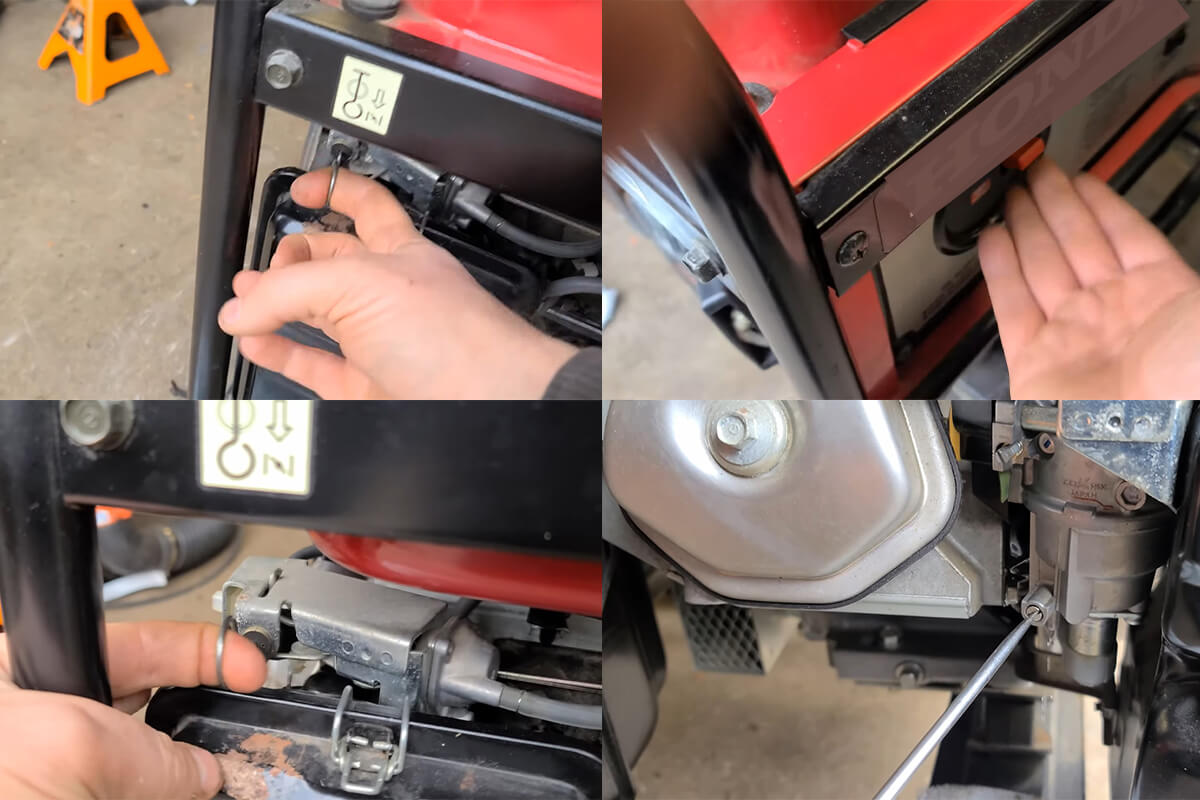how to store a generator?
- BY BISON
Table of Contents
Generators have long become an essential powerhouse for homes and businesses alike, providing much-needed resilience in the face of unpredictable power outages. They grant us the ability to maintain our daily routines unhampered, powering everything from the indispensable refrigeration for our food to our business-critical systems. However, while the acquisition of a generator is unquestionably invaluable, maintaining its longevity through appropriate storage is equally pivotal.
Key storage considerations encompass several interconnected factors that work together to preserve your generator’s condition. This blog is designed to guide you on how to store your generator wisely. Following these basic principles can increase the life and reliability of a generator, whether it is a portable, standby, or inverter generator.

7 steps to properly store your generator
Ensuring the proper storage of a generator is crucial for maintaining its durability and efficiency. To safeguard the generator from damage and guarantee its readiness for use, it’s vital to handle fuel and oil appropriately and conduct routine maintenance assessments.
Attending to these steps will not only ensure your generator is ready for its rest phase. Still, it will also take a proactive stance in maintaining its optimal functionality throughout its service life.
#Step 1: Check the oil
If your generator has no leaks and is in good condition, it will not consume too much oil. However, it is necessary to check and replenish the amount of oil before storing it. Typically, for most generators, this only requires a small amount of oil, about a couple of teaspoons, of regular motor oil.
#Step 2: Drain or stabilize the fuel
It’s essential to inspect the condition of the oil and fuel before storing your generator. When stored for longer periods, fuel can deteriorate and result in gum formation that can clog fuel systems. To avoid this, consider draining the fuel tank and fuel lines or use a fuel stabilizer. The aim here is to either remove or stabilize the fuel, which inhibits the degradation process, preserving your generator’s engine condition.
#Step 3: Check your generator
Watch out for any oil or fuel leaks; these could lead to the risk of both internal damage as well as potential fire hazards. It’s also imperative to check for damaged parts — belts, wires, or anything that seems out of order should be repaired or replaced before storage.
#Step 4: Maintenance inspection
Regular maintenance aspects, especially before storage, should include changing air filters, spark plugs, and generator oil. These maintenance checks are essential for maintaining a clean, proper running condition of the generator, enhancing its overall performance, and increasing its lifespan.
#Step 5: Clean your generator for storage
Before packing it away, your generator deserves a thorough cleaning. Wipe down the exterior to remove any accumulated dirt or dust. Also, clean the cooling fans and vents to prevent overheating and enhance ventilation. Ensure the storage area is also clean to avoid any potential pests that could damage your generator.
#Step 6: Arrange protection measures
- Covering: Use a breathable, properly sized canvas or weatherproof fabric cover with ventilation panels. Avoid plastic tarps that absorb moisture. Place the generator on a raised platform and place silica gel packets around the unit.
- Pest control: Use fine mesh to seal openings, focusing on the air intake and exhaust vents and gaps where small animals could enter. Steel wool can be used for larger gaps.
#Step 7: Store it in a dry, cool place
The ideal storage location for a generator is a dry, well-ventilated area. This will help prevent moisture from building up and causing rust or corrosion. Likewise, avoid storing the generator in areas where it may be exposed to extreme temperatures, such as direct sunlight or freezing temperatures. It’s also important to ensure that the generator is stored on a level surface. This will help prevent damage to the fuel system and other components.

Choosing the right storage location
Can a generator be stored in a basement, spare room, or anywhere else in the home? In short, no. Even when the tank is empty, fuel-fired generators can release trace amounts of chemicals, odors, and toxic fumes into your living space.
Instead, consider housing your generator in a secure location, such as:
Garage
Indoor storage offers enhanced protection against harsh environmental elements such as heavy rainfall, snow, or intense sun exposure. It can also provide additional security from theft. If it has ample clean and ventilated space, a garage (preferably separate from the house) can serve as a convenient storage option. Temperature control and easy access to the house are additional advantages of storing your generator in a garage.
Outdoor shed
A robust storage shed or a basic, ventilated wooden structure can be an option, as it is safely positioned farther away from the house. This can completely avoid potential indoor risks such as smoke accumulation and fire. However, temperature control may be a concern. Storing generators in extreme heat or cold can potentially damage them. Consider your climate to determine whether adding a heat shield will provide adequate protection for shed storage.
Long-term storage maintenance
A systematic approach to long-term maintenance prevents performance degradation and identifies potential problems before they become costly failures.
Regular inspections and startups
Perform a monthly routine to check the overall condition of the generator. Check for signs of moisture intrusion, pest activity, or visible damage to components. And test all safety systems and controls.
Seasonal maintenance schedules should match local weather patterns and the length of storage. Perform a complete start-up procedure every three months to circulate fluids and ensure all systems are functioning properly. Run the generator under light load for 15-30 minutes to maintain engine seals and prevent gelling of the fuel system. During the spring and fall transition, perform a thorough inspection that includes checking the air filter, inspecting the spark plugs, and verifying the cooling system.
If using a fuel stabilizer, check its effectiveness every six months and add a new stabilizer as needed. If long-term storage exceeds six months, consider completely draining the fuel system and running the engine dry to prevent varnish buildup.
Battery care for electric start models
- Check battery voltage monthly and charge if the voltage is below manufacturer specifications (typically about 12.4 volts for a 12V system).
- Terminals should be cleaned and protected every two months during storage. Remove corrosion using a wire brush and baking soda solution, then rinse with clean water and dry thoroughly.
- Apply corrosion inhibitor to exposed metal surfaces and spray electrical connections with a moisture-blocking lubricant.
Documentation and recordkeeping
- Record inspection dates, problems found, maintenance performed, and any parts replaced.
- Record environmental conditions and any abnormalities during storage.
Preparation for use after storage
Pre-start checklist
Perform a thorough visual inspection to check for damage, corrosion, or insect infestation. Remove all protective covers and storage materials. Check air filters, spark plugs, fuel lines, and connections. Make sure all vents are unobstructed.
Fuel and oil level verification
Check engine oil level and oil level, replace if dark or contaminated.

Commissioning procedure
Start the generator according to the manufacturer’s procedure and warm it up for a few minutes without load. Gradually increase light loads and test all interfaces and functions. Run for 30 minutes under different conditions. During this test, observe for any unusual noises, vibrations, or performance problems.
Common problems and troubleshooting
Failure to start (check fuel quality, spark plugs), rough running (need to clean carburetor), battery problems (charge/clean connection wires), and low power output (dirty filter, bad fuel). For more detailed information, please see “BISON generator maintenance” or “BISON generator repair“.
Conclusion
Don’t hesitate to start implementing these best storage practices today. The key storage steps outlined in this article—careful storage procedures, choosing the right storage environment, maintaining a consistent long-term maintenance program, and systematic preparation for return to service—work together to avoid costly repairs and guarantee reliable power when you need it most.
BISON is a leading generator supplier with an extensive product line and innovative technologies. Every BISON generator undergoes rigorous quality testing and features advanced fuel efficiency technology to ensure less unplanned downtime.
Partner with BISON today to enjoy our most professional service and after-sales support. Our team of experts is ready to help you ensure that your BISON generator is not only stored properly but also reliably cared for when the lights go out.
contact us
related product categories
Get in touch to speak with our experts!




